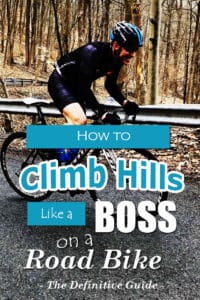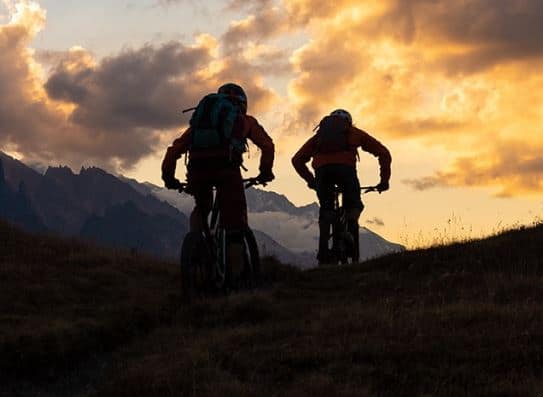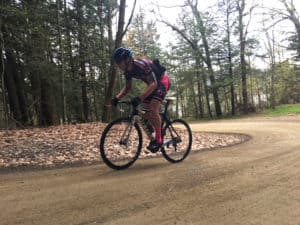- The Ultimate Guide to Women’s Specific Bikes - October 5, 2021
- Top Road Bikes Under $1000: Grab More Speed for Less Cash - October 5, 2021
- Get Fast! 8 Top Carbon Fiber Road Bikes Under $2,000 - October 5, 2021
Have you ever wondered why climbing a hill is so tough on a bike? Before you go trading in your bike for an ultra-light model or cutting the doughnut food group from your diet, try these tips on your next ascent.
What’s the Deal with Power to Weight Ratio?
When it comes to climbing, a rider’s power to weight ratio matters. Strong riders who are also lean, can blow apart a group when the road turns up. Why is this? Gravity favors the thin and I’ll show you exactly why. Let’s set up a theoretical hill climb:
- Rider A weighs 220 pounds (100kg) and puts out 300 watts (3 watts/kg)
- Rider B weighs 154 pounds (70kg) and produces 250 watts (3.6 watts/kg)
- Rider B is faster, despite producing 18% less power
Losing weight is never a bad thing, assuming you have it to lose. However, anyone will benefit from focusing on gaining strength, which tends to positively impact weight as well as all other aspects of cycling fitness.
The Dirt Roamer Series is Patagonia’s lightest and most breathable MTB kit—a reactive, fully integrated system that pairs on-body storage with packable weather protection. The result is a human-powered riding system that allows unfettered mobility to chase the next mile … and the one after that.
Is There Such a Thing As a Natural Climber?
Before we tackle this question, let’s quickly take a tour of our muscle fibers. We have two types: fast twitch and slow twitch. Fast twitch fibers are responsible for those quick accelerations, and other short bursts of energy, like sprints. These fibers are anaerobic, meaning they don’t need oxygen. The downside is that they fatigue quickly and produce lactic acid (feel the burn!).
The flipside is slow twitch. These muscle fibers are fueled by oxygen, are slow to fatigue and what we utilize the most. It’s important to note that at any given time, we’re actually utilizing a combination of these muscle fibers.
Some of the best natural climbers not only have a high V02 max, providing them with a big engine capacity, but also have a special blend of muscle fibers that result in producing some mega-power at their threshold.
Tips to Climb Like the Genetically Gifted
- Train just below the red zone (at threshold). This is the point where your legs burn, lungs gasp and heavy legs set in.
- Climb at a pace that you can sustain with even breathing.
- To avoid the leg-draining red zone, climb seated and avoid fast accelerations
- Maintain an even speed
Embrace Mental Toughness
If there’s one big secret to climbing, this is it. The best climbers have the ability to dig deep and suffer long and silently. Frequently practice placing yourself amid the misery and playing mind games is the best way to emerge over the top as the victor.
Here are my favorite mind games:
- Break the hill into smaller chunks. Pick out mail boxes, poles or street signs and focus solely on getting to that point, not to the top of the hill. Practice this and your goal is never more than a few pedal strokes away.
- Another fun trick is to have fun with your riding buddies by testing their mental fortitude. Put in a little acceleration and see if they can follow or pass them with a huge smile and watch their defeated look as they fade off the back.
Position Yourself For Success
While mountain bike bars don’t have a lot of hand position options, unless you have barends, road bikes offer a variety of positions to practice climbing in. But which ones are the best?
Climbing on the Hoods
- Allows you to slide forward on the saddle, engaging the quads (ie: climbing with lots of power)
- A decreased hip angle allows you to recruit the hip flexors
- Despite its power, it’s also energy-sapping and will also deliver a blow to your undercarriage
- Use it to close a slow opening gap
Climbing on the Tops (or mountain bike climbing position)
- Allows you to explore the saddle. Slide forward to engage the quads or back to tap into the powerful glutes and hamstrings. The latter will fatigue slower than the quads, so aim to get comfortable here.
- Opens up the chest to allow for easier breathing
- Try this on long climbs
Climb Out Of the Saddle
- Pop up out of the saddle for a few pedal strokes when the former positions start to tire. On a long climb, you’ll want to keep varying positions.
- Hanging out here too long is tiring.
- Use it for quick accelerations or attacks.
Climbing In The Drops
- Use when sprinting uphill to leverage the bike powerfully from side-to-side
- Great for climbing into a headwind or climbing on loose gravel
- Use it sparingly, as it’s very tiring.
Will I Climb Faster With a Lighter Bike?
Light bikes are awesome and fun, but they’ll also lighten your wallet and won’t magically replace any fitness or or techniques mistakes you’re already making.
That being said, here’s how to get the most out of the equipment you already have or can cheaply upgrade. Here are a few considerations:
- Are you using the best gear ratio? If you’re a masher or a spinner, be sure you have gears you can comfortably turn over on the climbs you most frequently ride. If you’re overgeared, a lighter bike won’t make much of a difference.
- Focus on fit. Prioritize comfort over weight.
- Swap out gearing to match your terrain. Have a variety of chainrings and cassettes for different topographies.
The Dirt Roamer Series is Patagonia’s lightest and most breathable MTB kit—a reactive, fully integrated system that pairs on-body storage with packable weather protection. The result is a human-powered riding system that allows unfettered mobility to chase the next mile … and the one after that.



